人教版新目标初中英语八年级下册How long have you been collecting shells教案2篇
-
- 页数:33页
- 字数:约 40563 字
- 大小:183.00KB
- 格式:.doc
- 版本:Office2016及以上版本
- 作者:Tovelo_PPTer
How long have you been collecting shells教案2篇
How long have you beencollecting shells?教案一
第一课时
一、学习目标
1.学会谈论自己对某些爱好持续的时间长度。
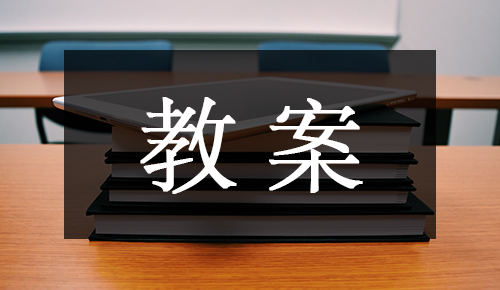
如:过去有什么爱好,持续了多长时间,目前有什么爱好,这个爱好到目前持续了多长时间。
2.学会就上述问题向别人进行询问。
3.通过谈论自己有什么收藏爱好,持续了多长时间,有多少收藏品,学会for和since的用法。
4.学会就上述问题向别人进行询问。
二、学习内容
目标分类学习内容
词
汇 collect, shell, skate, inline, inline skating,marathon, since, a pair of, raise, several, snow globe, monster, probable, runout of, store, particularly, polar bear, let know, collector, by the way,bamboo, silk, common, topic, be interested in
语法句型
I.如何表示“从过去开始一直持续到现在,有可能还要持续下去的动作”。我们用下面的句式来表示这一概念:
主语 + have / has been + 现在分词,如:
1.She has been skating for four hours.
到现在为止她滑冰已经有四个小时了。
2.I have been collecting stamps since I was tenyears old.
我从十岁起就一直在集邮。
II.如果想询问别人“做一件事有多久了?”,我们用“How long have/ has +主语 + 现在分词?”这样的句式来提问,如:
1.How long have you been studying English?
你学英语有多久了?
2.How long has your father been working in thecompany?
你父亲在这个公司工作有多长时间了?
III.学会“since”和“for”在表示时间时的用法。
IV.区分“主语 + have / has been + 现在分词”和“主语 + 动词过去式”这两个句式的不同点及熟练掌握这两个句式的用法。
功能 Talk about how long you have been doing things
(谈论你做某件事情有多久了)
三、朗读单词
1. collect v. 收集, 聚集, 集中, 搜集
2. shell n. 贝壳, 壳, 外形, 炮弹
3. inline adj. 一列式的;排成行的
4. inline skating 纵列式滑冰
5. marathon n. [体]马拉松赛跑 (全长42,1954米)
6. a pair of 一对;一双;一副
7. raise v. 募集;筹措
8. several adj. 几个的,数个的
9. stamp n. 邮票, 印花, 印, 图章
10. globe n. 球体;球形玻璃器
11. snow globe 里面有雪花的球形玻璃器
12. monster n. 怪物, 妖怪
13. probably adv. 大概, 或许
14. run out of (储存物、供应品等)用尽;缺乏
15. store vt. 贮藏, 贮备, 存储
16. room n. 空间
17. particularly adv. 独特地, 显著地
18. polar adj. 北极的;南极的;近极点的
19. polar bear 北极熊
20. anyone pron. 任何人
21. let know 告知;使知晓
22. collector n. 收藏家,收集者;搜集者
23. by the way 顺便说一句
24. bamboo n. 竹子
25. silk n. 丝绸
26. common adj. 共同的;普通的;常见的
27. free adj. 自由的;物拘束的
28. topic n. 话题;主题;题目
29. be interested in 对……感应趣
四、任务示范
学生们正在进行马拉松滑冰比赛,比赛已经进行了一段时间,有些同学还在滑,有人已不滑了。请根据下面短文用“how long”编一个对话。
同学们在做这个练习时要注意如何询问别人“做一件事有多久了?”
The students are having an Inline SkatingMarathon. Alison has been staking for five hours. Victor has been skating forfive hours, too. But San skated for four hours. He is tired. He is sitting onthe ground and having a test. He has been having a rest for about one hour.
下面请听老师示范(Pairwork):
A: How long has Alison been skating?
B: He has been skating for five hours.
A: How long has Victor been skating?
B: He has been skating for five hours, too.
A: How long did San skate?
B: He skated for four hours.
A: How long has he been having a rest?
B: He has been having a rest for one hour.
好,我们再做一次,这次你可跟老师一起做。
五、布置作业
1.请同学们反复朗读单词,并自查能记住多少单词。
2.听录音:Section A 1b, 2a, 和2b
3.预习Section A 3a
附:听力原文
P44 1b
Woman: Alison, how long have you been skating?
Alison: I’ve been skating for five hours.
Woman: Wow! Sam, how long did you skate?
Sam: I skated for four hours. I started at nineo’clock in the morning and
stopped at one o’clock in the afternoon. I’m verytired!
Woman: When did you start skating, Victor?
Victor: At nine o’clock.
Woman: So you’ve been skating for …
Victor: I’ve been skating for five hours.
Woman: How long did you skate, Celia?
Celia: Umm, let’s see … I skated for two hours.
答案:
Alison: I’ve been skating for five hours.
Sam: I skated for hour hours.
Victor: I’ve been skating for five hours.
Celia: I skated for two hours
P45 2a, 2b
Reporter: Alison, congratulations on winning theskating marathon!
Alison: Thank you.
Reporter: So, how long did you skate today?
Alison: For six hours!
Reporter: Was this your first inline skatingmarathon?
Alison: No, I skated in a marathon last year.
Reporter: You’re an excellent skater, Alison. Doyou skate every day?
Alison: Yes, I do.
Reporter: How long have you been skating?
Alison: Since I was seven years old. I got myfirst pair of skates on my
birthday from my grandmother …
答案:
2a: The following questions should be checked: 1 34 6
2b: 1. c 3. a 4. b 6. d
How long have you been collecting shells? 第二课时
第二课时
一、任务示范及讲解
1.通过打电话的方式了解同学们有什么爱好(如:打篮球、弹钢琴、学英语等);这个爱好持续了多长时间?在过去某一个时间里是否做过这件事(如:昨天、前天、上个星期等等);做了多长时间?
Name Hobby How long (for) Time (past) How long(for)
完成任务所需要的语言结构:
1. What’s your name?
2. What is your hobby?
3. How long have you been playing basketball?
4. I have been playing basketball for about tenyears.
4. How long did you play it yesterday?
5. I played it for about two hours.
下面请听老师示范:
Name Hobby How long (for) Time (past) How long(for)
Wang Gang play football for five years yesterdayone hour
Li Hong dancing for seven years last Sunday twohours
Zhao Ming swimming for four years last week tenhours
2.让学生自述自己做某一件事的情况。如:
I have been studying dancing for about five years.I danced for about two hours last
Saturday. 等。
3.通过打电话对本班的同学作一个采访,询问他 / 她正在做什么?做了多久了?是否打算继续做下去?并请同学们汇报调查结果
完成任务所需要的语言结构:
1. What are you doing?
2. When did you do it?
3. How long have you been doing it?
4. How long did you do it?
下面请听老师示范:
A: What are you doing?
B: We are watching a new movie.
A: How long have you been watching it?
B: We have been watching it for about ten minutes.
4.同学们,为了丰富你们的课余生活,学校准备组织课外活动小组。在组织活动小组之前,学校要对你们的爱好进行调查,你们有些什么爱好呢?这些爱好从什么时候开始的?到现在持续了多久?
请同学们通过这个练习学会“since”和“for”在表示时间时的用法。请看下面的例句:
1.The skating marathon has been going for eighthours.
2.I have been collecting kites for seven years.
3.He has been watching English movies since 1998.
4.I have been listening to music videos since I wasseven years old.
通过以上例句我们可以看出for后面接的是一个时间段:eight hours和 seven years,而since后面接的是具体的时间点:1998 (1998年)、I was seven years old(我7岁)。
首先听老师的示范,……,下面请同学们自己完成表格。
Name Hobby How long
since
for
since
for
since
for
完成任务所需要的语言结构:
1. I have been doing it since I was ten years old.
2. I have been doing it for six years.
老师示范:
Name Hobby How long
Wu Qing running since I have been running since Iwas a child.
for I have been running for five years.
Li Qiang collect kites since I have beencollecting kites since I was eight.
for I have been collecting kites for about sixyeas.
二.布置作业
1.听力练习
Section B 2a, 2b
2.预习Section B 3a
附:听力原文
P47 2a, 2b
Conversation 1
Girl: How long have you been collecting thesekites, Bob?
Bob: Since I was ten years old.
Girl: How many do you have?
Bob: Oh, I have about 22 so far.
Girl: Where do you fly them?
Bob: I usually fly them in the park when it’swindy.
Conversation 2
Boy: Wow, Marcia. Are these stuffed animals allyours?
Marcia: Yes, I’ve been collecting them for fiveyears.
Boy: How many do you have?
Marcia: Well, I have about 35.
Boy: Which ones do you like best?
Marcia: I like the panda best – he’s so cute! AndI also like the tiger. My
mother gave me that one.
Conversation 3
Girl: What do you collect, Liam?
Liam: I collect theater and movie tickets.
Girl: So how long have you been collecting them?
Liam: Since last year.
Girl: How many do you have?
Liam: I have 20. I put them in this book and writeif I liked the show or movie.
Girl: Looks like an interesting collection.
答案:
2a: Bob: kites
Marcia: stuffed animals
Liam: theater and movie tickets
2b: Bob: since he was ten years old, 22
Marcia: for five years, 35
How long have you been collecting shells? 第三课时
任务示范及讲解学生们说一说自己的hobby或收藏。
内容可以包括:What ? How long? When started?
Whether continue or not? 这项活动主要起复习和引导作用。
完成任务所需要的词汇:
stamp(邮票)、shell(贝壳)、model car(模型汽车)、 coin(钱币)、 kite(风筝)、 theaterticket(戏票)、stuffed animal(用海面、碎布等作填充材料的玩具动物)、 movie ticket
(电影票)
下面请听老师示范:
My name is Peter. I have been living in China forabout seven years. I like collecting stamps. I have been collecting Chinesestamps since I came to China. I have been collecting over three hundred Chinesestamps. I like Monkey King stamps best.
二.阅读预习与讲解
下面我们学习两篇小短文P 46 Section A 3a和P 48 Section B 3a。在你们读之前先由老师解释一下本文中出现的一些短语,以便易于你们学习。
Section A 3a
1. raise money for charity 为慈善机构慕钱
eg. We had a party to raise money for the doctorsand nurses last night.
昨天晚上我们举行了一个为医务工作者慕钱的晚会。
2. whole 整个的
eg. I have been studying for the whole eight hourstoday.
今天我已经学习了整整八个小时了。
3. an hour ago 一小时以前
eg. I played football an hour ago.
一个小时以前我踢球了。
Section B 3a
1. thanks for doing sth 为(做)某事感谢某人
eg: Thanks for helping me study English.
谢谢你帮我学英语。
2. in fact 事实上
eg: In fact I like to study in school.
事实上我还是喜欢在学校学习。
3. run out of 用尽;缺乏
We’ve run out of room to store them 我们缺少储存它们(snow globes)的空间
4. If you know anyone else who collects them, … 如果你知道谁也(喜欢)收藏它们,……
这是一个由if引导的条件状语从句,if在这里解释为“如果……”,在这个状语从句中又含有一个由who连接的定语从句,who在这里指anyone。
三.布置作业
2.阅读Section A 3a的短文,并完成表格。
1.阅读Section B 3a并做3b。
How long have you been collecting shells? 第四课时
一.疑难解析
I.如何表示“从过去开始一直持续到现在,有可能还要持续下去的动作”。如:到现在为止她滑冰已经有四个小时了。又如:我从十岁起就一直在集邮。我们采用如下的方法来表示“从过去开始一直持续到现在,还要持续下去的动作”:
主语 + have / has been + 现在分词,如:
1.She has been skating for four hours.
到现在为止她滑冰已经有四个小时了。
2.I have been collecting stamps since I was tenyears old.
我从十岁起就一直在集邮。
在这两个句子中,have和has是助动词,因此把助动词题签,就构成了一般疑问句,在have或has后面加not,就构成了否定形式,have not和has not可以分别缩写成haven’t和hasn’t 。如:
1.Have you been doing your homework since thismorning?
从今天早晨起你就一直在写作业吧?
(表明写作业这个动作从今天早晨就开始了,一直持续到现在,还要持续下去。)
2.I haven’t been seeing films for a long time.
我有很长时间没有看电影了。
(表明没有看电影这个动作从过去一直持续到现在,还要继续持续下去。)
II.区分“主语 + have / has been + 现在分词”和“主语 + 动词过去式”这两个句式的不同点及熟练掌握这两个句式的用法。
1.“主语 + have / has been + 现在分词”表示动作从过去开始一直持续到现在,并且还要继续持续下去。如:
He is a pianist. He has been playing the piano forabout twenty years.
他是一个钢琴家。他弹钢琴大约有二十年了。
弹钢琴这个动作从二十年前就开始了,一直持续到现在,由于他是个钢琴家,那么弹钢琴这个动作还要继续持续下去。这里强调持续,而不是二十年间他一刻不停地在弹琴。又如:
I have been collecting snow globes for sevenyears.
我收集里面有雪花的玻璃装饰品有七年了。
我有这个爱好,七年间我一直在收集这样的装饰品,但是不等于七年间我别的什么也没干。
2.“主语 + 动词的过去式”表式过去某个时间已经发生了动作,有比较明确的表示过去的时间状语。如:
I did my homework last night.
我昨天晚上做的作业。
表明“做作业”这个动作发生在昨天晚上,动作没有持续性。
二.写作指导
大家在学完这个单元以后要完成两个写作任务,即写一个招聘广告和一封应聘信。招聘广告可以模仿49页上的第3题来写,应聘信可参考第48页上的3a来写。
下面请看示例:
学校歌咏队要参加一个歌咏比赛,故而要招聘新成员,请你帮歌咏队写一个招聘广告。
应聘信
Dear Mike,
I’m from Class Two, Grade Two. I’m an outgoingboy. I am interested in singing songs. I have been singing songs since I wasfive years old. I have been studying English for six years, so I can sing manyEnglish songs. I am studying English songs now. Every Saturday I go to singingclub to study singing and English songs.
Yours sincerely
John
How long have you beencollecting shells?教案二
Period 1
1.KnowledgeObjects
(1)Key vocabulary: inline skating; marathon;skate; shell; collect
(2)Key structures: -How long have you beenskating?
-Ive been skating for five hours.
(3)Listening practice
2.Ability Object
To train students ability of listening andspeaking.
1. TeachingKey Points
Key vocabulary. Key structures. Listeningpractice.
2.Teaching Difficulties
How to improve students listening ability.
Pairwork.
How long have you been collecting shells?
A: How long has Alison been skating?
B: Shes been skating for five hours.
A: How long did Sam skate?
B: He skated for four hours.
时序教学操作过程设计(重点写怎么教及学法指导,含课练、作业安排)
Step Ⅰ Greet theclass and check the homework.
Step Ⅱ
Show the new words on the screen. Teach the newwords. Read the new words to students and ask students to repeat.
Step Ⅲ Section A
Draw a long horizontal line across the board. Say,This is called a time line. It shows the years from 19- to the present. Letsput some information about ourselves on the time line.
T: Maria, when did you start studying English?
S1:1997.
T: Maria started studying English in 1997.(Writethe words Maria started English above the date 1997 on the time line.)
In this unit were going to talk about how longweve been doing things. Maria, how long have you been studying English?
(Point to the date 1997 on the time line.)
S1:Since 1997.
T:(Look at the class.)Correct. Maria has beenstudying English since 1997.(Point to the starting date and run the fingeralong the years up to the present year.)Class repeat. Maria has been studyingEnglish since 1997.
Ss: Maria has been studying English since 1997.
Repeat the activity using different dates forseveral other students. Use a different situation, such as When did you startto ride a bicycle? or When did you start to baby-sit? if these questions aremore appropriate. Each time ask the class to repeat a sentence, point to thestarting date and run the finger along the years up to the present year.
Step Ⅳ 1a
This activity provides oral practice using thetarget language.
Go through the instructions with the class. Say,You will be talking with other students about some things you did in the last24 hours.
Write the words at and for on the blackboard. Say,You will be using the words at and for in some answers.
Divide the students into some groups. Let studentslook at the three questions and read them to the class.
(1)How long did you sleep last night?
(2)When did you start class today?
(3)How long have you been in class today?
Then get students to ask and answer thesequestions in groups. Let them look at the words at and for on the blackboard.Say, Use the two words in sentences like this: I started class at 10:00.I sleptfor ten hours.
While students work in groups, move around theroom checking their progress and offering help as needed.
Ask the class each question and let severaldifferent students answer. Help the students phrase responses using the wordsat and for correctly.
Step Ⅴ 1b
This activity gives students practice inunderstanding the target language in spoken conversation.
First tell students, Were going to listen to arecording of a reporter talking to the participants in an inline skatingmarathon.
Let students look at the picture and tell what ishappening. Help the students understand that the students in the picture are ata skating marathon. Then discuss with students what a marathon is.(Its acontest to see who can do something-run or dance or skate-the longest withoutstopping.)
Ask a student to read the instructions, and thename in the chart. Then say, You will write sentences about these peopleaccording to the recording.
Get a student to read the sample answers.
Ive been skating for five hours.
I skated for four hours.
T: What word comes before the number of hours?
S: For.
T: Thats right. We use the word for when we talkabout a number of hours. We say for five hours or for ten days.
Play the recording for the first time. This timestudents only listen. When play it a second time, say, This time listen to thetape carefully and write the sentences in the chart.
Correct the answers.
Answers
Alison: Ive been skating for five hours.
Sam: I skated for four hours.
Victor: Ive been skating for five hours.
Celia: I skated for two hours.
Step Ⅵ 1c Pairwork
This activity provides guided speaking andlistening practice using the target language.
Ask a student to read the instructions aloud. Andlet students look at the picture in Activity 1a.
Have two students read the example in sampledialogue in Activity 1c.
Then say, Now work with your partner. Begin withreading the conversation in the box with your partner. Then make a conversationabout the people in the picture. You can use the names and sentences inActivity 1b.Are you clear? OK. Begin, please.
As students work, move around the room, checkingtheir progress. Offer language support if necessary.
At the end ask several pairs of students to saytheir conversations to the class. Give them little presents if they do theirwork better.
Step Ⅶ Optional Activity
Write these words on the board in random order:how, long, have, you, been, studying, English, going to school, playing soccer,riding a bicycle. Then give a student a pointer and ask him or her to tap thewords one by one to make a question. For example the student might tap thesewords: how...long...have...you...been...riding...a...bicycle. Then the studentcalls on another
student to answer the question. Give severalstudents a chance to tap out questions.
Step Ⅷ Summary and Homework
Today weve learned some key vocabulary andstructures. Continue to make conversations with your partner after class. Nexttime Ill ask some pairs to read your conversations to the class again.
课题 How long have you been collecting shells? Period2
1.KnowledgeObjects
(1)Key vocabulary: since; pair; a pair of
(2)Key structures
Pairwork.
(3)Grammar focus
2.Ability Objects
To train students listening skill.
To train students communicative competence.
1.TeachingKey Points
Vocabulary and structures.
2.Teaching Difficulties
Groupwork
Grammar focus.
How longhave you been collecting shells?
A: How long have you been skating?
B: Ive been skating since I was seven years old.
A: How long have you been skating?
B: Ive been skating since nine oclock.
A: How long did you skate?
B: I skated for two hours
时序教学操作过程设计(重点写怎么教及学法指导,含课练、作业安排)
Step Ⅰ Greet theclass and check the homework.
Ask a pair of students to say their conversation.
S1:How long has Victor been skating?
S2:Hes been skating for five hours.
S1:How long did Celia skate?
S2:She skated for two hours.
T: Very good. Thank you.
Step Ⅱ
Show the new words on the screen. Read the newwords to the class and ask them to repeat. Make sure every student canunderstand the meanings of the new words.
since conj. 自……以后;自从
pair n. 一双;一对;一副
a pair of 一双;一对;一副
Step Ⅲ 2a
This activity gives students practice inunderstanding the target language in spoken conversation.
Go through the instructions with the class. Lookat the six questions and ask different students to read the questions to theclass. Then rephrase them in simple words. For example question 1 can berephrased as How many hours did you skate today? Ask students what questionsthey still dont understand and explain the questions further as needed.
Then say, Youll listen to a recording of areporter talking to Alison. Please check the questions you hear. The first oneis given to you as an example. Do you understand? OK. Lets listen to therecording now.
Play the recording the first time. Students onlylisten. Play it a second time. This time students put a check in front of thequestions they hear.
Then check the answers.
Answers
The following questions should be checked:1 3 4 6
Step Ⅳ 2b
This activity gives students practice inunderstanding the target language in spoken conversation.
Say, Listen to the interview with the inlineskating marathon winner again. Draw lines to match the questions and answers inActivity 2a.
First point out the line drawn for the sampleanswer. Ask a student to read the example.
-How long did you skate today?
-For six hours.
Get a student to read the other answers to theclass. Then say, You will use these answers to answer the questions you checkedin Activity 2a.
Play the recording and let students draw lines connectingeach question with the correct answer:
Play the recording again and have students checktheir answers.
Answers
1.c 3.a 4.b 6.d
Step Ⅴ 2c
This activity provides guided speaking andlistening practice using the target language.
In this activity first ask students to look at thepicture and ask, whats happening in the picture?(A reporter is interviewingthe skating marathon winner.)
Have two students to read the example in sampledialogue in Activity 2c.
A: How long have you been skating?
B: Ive been skating since I was seven years old.
Then say, You will work with your partner. Roleplay the interview between Alison and the reporter.
Let students work in pairs. When they work, movearound the room checking the progress of the pairs and offering help as needed.
At the end ask a pair of students to say theirconversation to the class.
Step Ⅵ Grammar Focus
Review the grammar box first. Divide the classinto two group. One group read the statements and the other the responses.
Group 1:How long have you been skating?
Group 2:Ive been skating since nice oclock.
Ive been skating for five hours.
Group 1:How long did you skate?
Group 2:I skated for two hours.
Then write some how long have you been...questionson the board using topics that are interesting to students. For example, Howlong has Alice been playing tennis? or How long has Alice been taking pianolessons? Then write the words since and for on the board. Ask differentstudents to answer the questions using these words. Two answers might be: He hasbeen playing tennis since 1997.He has been playing tennis for three years.Circle the words since and for in the sentences.
Ask, When do you use since and when do you usefor? Help students understand that in these sentences since comes before adate, and for comes before a certain number of years.
Then do another example in which the answer willbe a time of day. For example, How long have you been sitting in thisclassroom? Again circle the words since and for. Help students understand thatin these sentences since comes before a clock time, and for comes before acertain number of minutes or hours.
Point to the second and third sentences in theGrammar Focus chart. Ask, What is the difference between How long did youskate? and How long have you been skating? Help students understand that thedid question means that the person has stopped doing the action. The have youbeen question shows that the person is continuing to do the action at thepresent moment.
Step Ⅶ Summary and Homework
This class weve done listening and speakingpractice using the target language. We must pay attention to the usage of thetwo words since and for.
Todays homework is to continue to make someconversations will your partners. Then revise grammar focus. Next time Ill asksome pairs to say their conversations.
课题 How long have you been collecting shells? Period3
1.KnowledgeObjects
(1)Key vocabulary: raise; charity; several
(2)Key structures
(3)Reading practice
2.Ability Objects
To train students reading skill. writing skilland communication
3.Sensibility and Value
To enable to ask for help when having difficultiesin learning.
1.TeachingKey Points
Key vocabulary and structures.
Reading practice.
2.Teaching Difficulty
Groupwork.
How long have you been collecting shells?
A: Liu Ying, what sport do you play?
B: Tennis.
A: When did you start?
B: When I was eleven.
A: So how long have you been skating?
B: Three and a half years.
时序教学操作过程设计(重点写怎么教及学法指导,含课练、作业安排)
Step Ⅰ Greet theclass and check the homework.
Ask a pair of students to say their conversationabout the interview.
S1:How long did you skate today?
S2:For six hours.
S1:Was this your first inline skating marathon?
S2:No,I skated in a marathon last year.
S1:How long have you been skating?
S2:Since I was seven years old.
T: Excellent. Thank you.
Step Ⅱ
Show the new words on the screen. Teach the newwords and read the new words to students. And ask students to repeat the words.
raise v. 募集;筹措several adj. 几个的;数个的
Step Ⅲ 3a
This activity provides reading practice using thetarget language.
Go through the instructions with the class. Say,This activity asks you to give answers using language from this unit and fromthe past units.
Look at the picture. Ask, What is happening in thepicture?(Some people are skating. A reporter is reporting the skatingmarathon.)Marathon means a long race. Do you remember?
Use a projector to show the passage on the screenand read the message to students.
Im talking to you from the Hilltop School SkatingMarathon. Here, students are skating to raise money for charity. For every hourthey skate, each student raises ten yuan for charity. The skating marathon hasbeen going for five hours now, and several skaters are still skating. Alisonwas the first one to start, and has been skating for the whole five hours. Nextis Sam, and he has been skating for six hours. Lu Ning has been skating forfour hours, and Li Chen just started an hour ago.
Ask some students to read the passage aloud.
Point out the sample answer. Then have studentsfill in the table. Walk around the room when students work, checking theprogress.
Check the answers.
Answers
Sam4 hours
Lu Ning4 hours
Li Chen1 hour
Step Ⅳ 3b
This activity asks students to calculate the timestudents started the race.
Go through the instructions with the class.
Ask students to go over the passage in 3a again.Then let them write the names from 3a on the time line. When students work,move around the room, checking the progress.
Check the answers.
Answers
Alison 9 a.m.;
Lu Ning 10 p.m.;
Sam 10 a.m.;
Li Chen 1 p.m.
If time permits, ask students to say somethingabout the people according to the time line.
Step Ⅴ 4 Groupwork
This activity presents an opportunity for studentsto use the language and structures of the unit to find out information aboutother students hobbies.
First ask two students to read the sampledialogue.
A: Liu Ying, what sport do you play?
B: Tennis.
A: When did you start?
B: When I was eleven.
A: So how long have you been skating?
B: Three and a half years.
Then let students look at the survey table. Askthem to fill in the table.
Ask students to complete the work in groups.Students list and discuss their different sports.
Get a few students to share their lists. Ask a fewstudents to say the sample conversation. For example:
S1:Li Ping, what sport do you play?
S2:Soccer.
S1:When did you start?
S2:When I was eight.
S1:So how long have you been playing soccer?
S2:Seven years.
Step Ⅶ Summary
This class weve read a passage and done a survey.Also weve done some exercises of the workbook. It made us strengthen thetarget language we had learned in Section A.
Step Ⅷ Homework
Review the new words. Next class Ill have youread the new words first.
课题 How long have you been collecting shells? Period4
1.KnowledgeObjects
(1)Key vocabulary: stamp
(2)Key structures
(3)Listening practice
2.Ability Objects
To train students listening skill and ability ofcommunication
3.Sensibility and Value
To be able to share our own collections withothers.
1.TeachingKey Points
Key vocabulary.
Key structures.
Listening practice.
2.Teaching Difficulty
Pairwork.
How long have you been collecting shells?
coins
kites beautiful
dolls interesting
toy animals
stamps
时序教学操作过程设计(重点写怎么教及学法指导,含课练、作业安排)
Step Ⅰ Greet theclass as usual and check the homework.
Ask students to show their reports and get some ofthem to read their reports to the class. Put some of the reports up on thebulletin board so that students can discuss it after class.
Step Ⅱ
Show the new word on the screen. Read the new wordto the class and ask students to repeat.
stamp n. 邮票
Step Ⅲ Section B 1a
Show some pictures on the screen and ask studentsto say something about the pictures. Provide key words as needed. Write thesewords on the blackboard.
Point to the pictures. Ask different students tosay the items they see in the pictures. Write the key words on the board afterstudents point out these words in the pictures. Get the class to repeat thename of each item.
Go through the instructions with the class. Pointto the chart. Ask a student to read the sample answer under the words Icollect. Say, This column is for things you already collect. Point to the wordsI would like to collect. Say, This column is for things you dont collect now.Its for things you want to collect in the future.
Let students write the names of things theycollect and things they would like to collect in the chart. Have students dothe work on their own.
When students finish, let different students readtheir lists to the class. If there are any new words, write them on the boardand ask the student who said each word to explain what it is.
Step Ⅳ 1b
This activity provides oral practice using thetarget language.
Go through the instructions with the class. Say,You will be talking with other students about your collection.
Let a student read the sample sentences.
A:I collect shells because they are beautiful. Idlike to collect stamps because they are interesting.
Ask, Why do you collect shells? Why do you want tocollect stamps? Write the words beautiful and interesting on the board .Say,These words tell why he collects these things. Use words like these in youranswers.
Have students do the activity in pairs. When theywork, move around the room, checking their progress. Offer helps as needed.
Ask several pairs of students to say theirconversations to the class.
Step Ⅴ 2a
This activity gives students practice inunderstanding the target language in spoken conversation.
Say, You will hear three conversations. They areabout Bob, Marcia, and Liam and their collections. Write what each personcollects under the word What.
Play the recording for students the first time.This time students only listen. Then play the recording a second time. Say,This time listen carefully and write what each person collects after thatpersons name and under the word What in the chart.
Correct the answers.
Answers
Bob: kites
Marcia: stuffed animals
Liam: theater and movie tickets
Step Ⅵ 2b
This activity gives students practice inunderstanding the target language in spoken conversation.
Point to the chart in Activity 2a.Say,Listen tothe recording again. This time you will be writing answers in these columns.You will be telling how long the person has been collecting things and how manyof each thing they have.
Play the recording. If necessary, pause it aftereach conversation to give students time to finish writing their answers.
Correct the answers.
Answers
Bob: since he was ten years old,22
Marcia: for five years,35
Liam: since last year,20
Step Ⅶ 2c Pairwork
This activity provides guided speaking andlistening practice using the target language.
Let students ask and answer questions about Bob,Marcia, and Liam.
First point to the example in sample dialogue.
A: What does Bob collect?
B: He collects kites.
A: How long has he been collecting kites?
B: Hes been collecting kites since he was tenyears old.
Then ask students to practice conversations inpairs. When students work, move around the room checking their progress andoffering help as needed.
At the end ask several pairs of students to saytheir conversations to the class.
Step Ⅷ Optional Activity
Play a memory game with the class. Ask questionssuch as Who collects stuffed animals? What does Liam collect? How long hasMarcia collected stuffed animals? How many tickets does Liam have? Ask studentsto answer in complete sentences.
Step Ⅸ Summary
This class weve learned some key vocabulary anddone some listening, speaking and writing practice.
Step Ⅹ Homework
Preview the new words on next page.
课题 How long have you been collecting shells? Period5
1.KnowledgeObjects
(1)Key vocabulary: snow globe; run out of; store;let know; by the way
(2)A reading passage
(3)Writing practice
2.Ability Objects
To train students ability of comprehension andwriting skill
3.Sensibility and Value
To be able to ask for help when havingdifficulties in learning.
1.TeachingKey Points
Key vocabulary words.
The reading passage.
Writing practice.
2.Teaching Difficulty
Writing practice.
How long have you been collecting shells?
now globe
monster
polar bear
penguin
birthday cake
时序教学操作过程设计(重点写怎么教及学法指导,含课练、作业安排)
Step Ⅰ Greet theclass as usual and check the homework.
您可能喜欢的文档
查看更多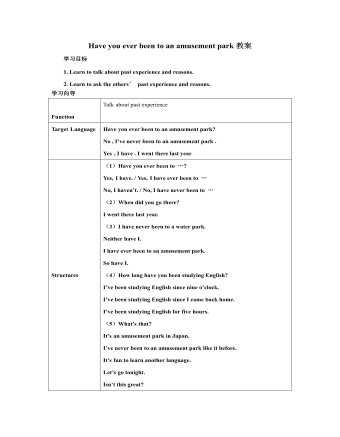
人教版新目标初中英语八年级下册Have you ever been to an amusement park教案
- 页数:10页
- |大小:113.00KB
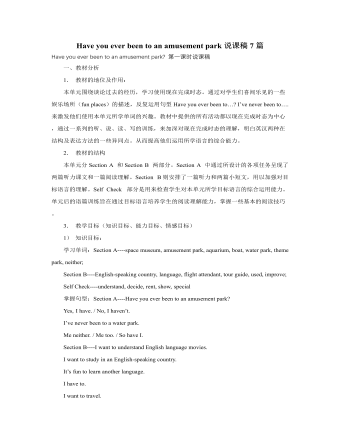
人教版新目标初中英语八年级下册Have you ever been to an amusement park说课稿7篇
- 页数:40页
- |大小:276.00KB
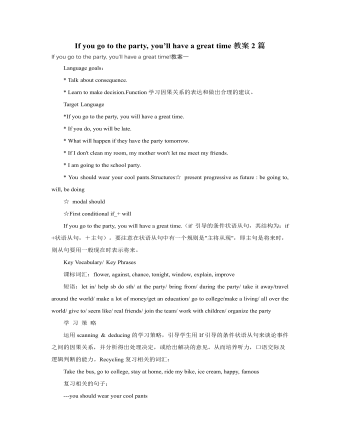
人教版新目标初中英语八年级下册If you go to the party, you’ll have a great time教案2篇
- 页数:25页
- |大小:200.00KB
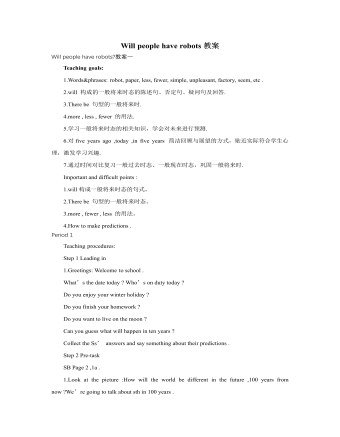
人教版新目标初中英语八年级下册Will people have robots教案
- 页数:26页
- |大小:231.50KB
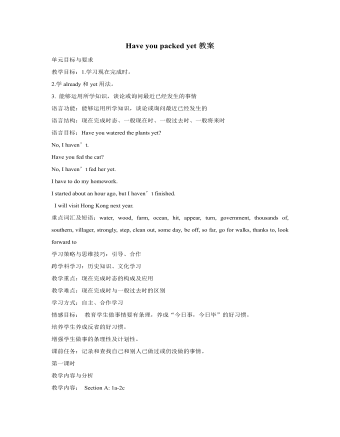
人教版新目标初中英语九年级下册Have you packed yet教案
- 页数:24页
- |大小:103.00KB
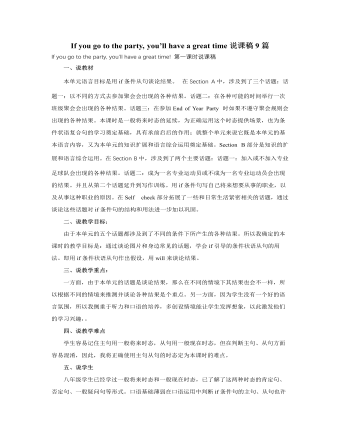
人教版新目标初中英语八年级下册If you go to the party, you’ll have a great time说课稿9篇
- 页数:32页
- |大小:189.50KB
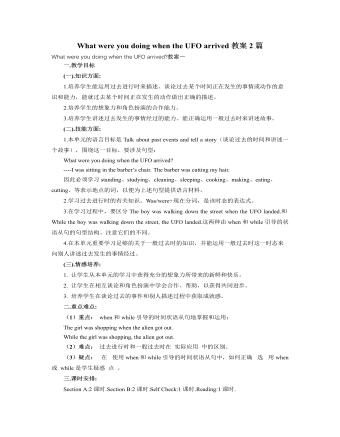
人教版新目标初中英语八年级下册What were you doing when the UFO arrived教案2篇
- 页数:12页
- |大小:106.50KB
热门课件教案
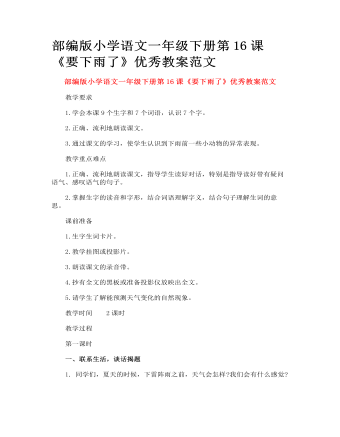
部编版小学语文一年级下册第16课《要下雨了》优秀教案范文
- 页数:4页
- |大小:19.94KB
- 课件教案
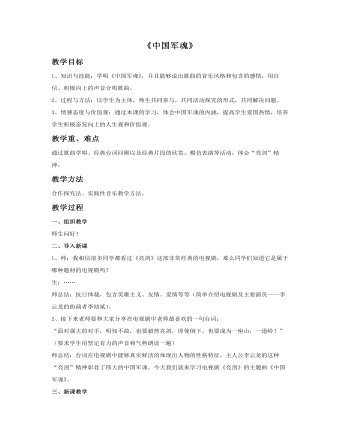
《中国军魂》教案
- 页数:2页
- |大小:33.00KB
- 课件教案

精选高中生期末评语
- 页数:42页
- |大小:7M
- 课件教案
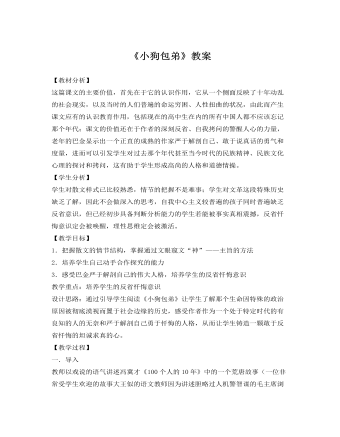
人教版高中语文《小狗包弟》教案
- 页数:8页
- |大小:29.21KB
- 课件教案
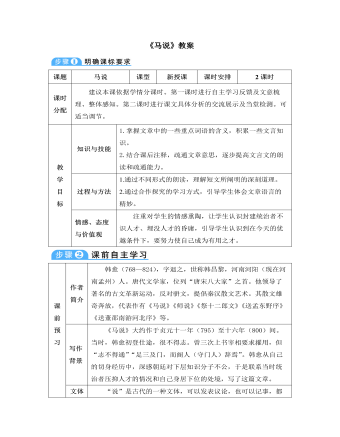
部编版语文八年级下册《马说》教案
- 页数:8页
- |大小:367.50KB
- 课件教案
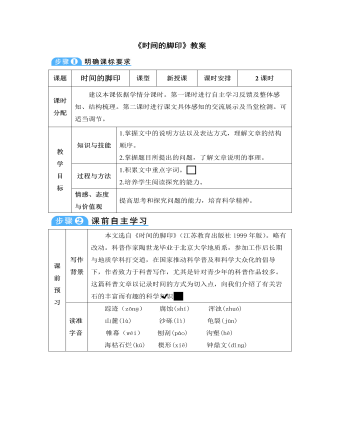
部编版语文八年级下册《时间的脚印》教案
- 页数:4页
- |大小:511.50KB
- 课件教案
今日更新

精选高中生期末评语
- 页数:42页
- |大小:7M

××县招商局2024年上半年工作总结
- 页数:12页
- |大小:142.54KB

“四零”承诺服务创建工作总结
- 页数:5页
- |大小:39.83KB
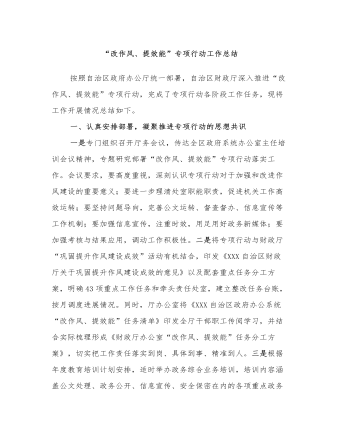
“改作风、提效能”专项行动工作总结
- 页数:6页
- |大小:139.05KB
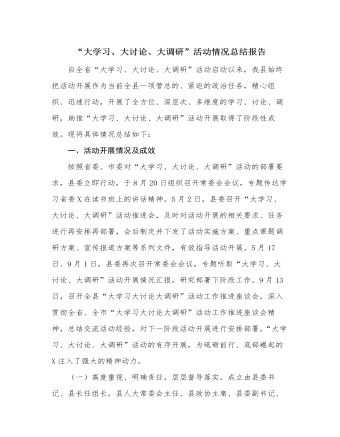
“大学习、大讨论、大调研”活动情况总结报告
- 页数:7页
- |大小:26.12KB
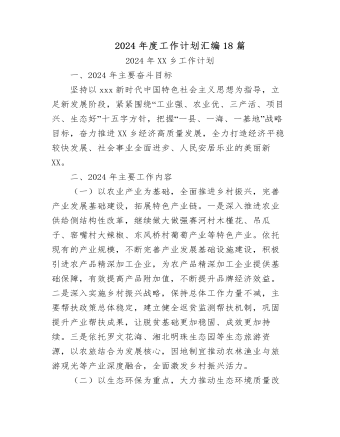
2024年度工作计划汇编(18篇)
- 页数:72页
- |大小:196.93KB





